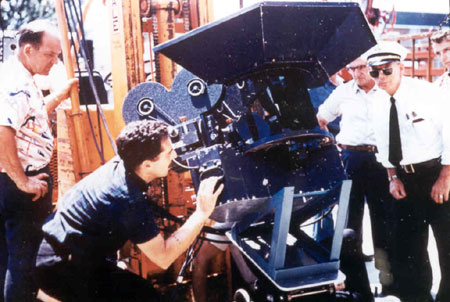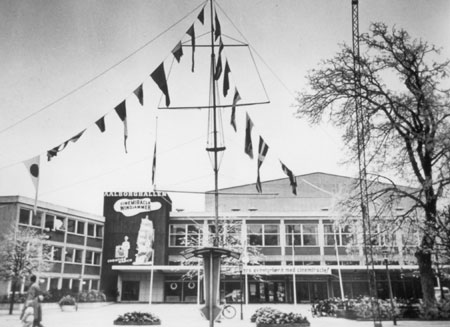The movie miracle in Aalborg | Read more at in70mm.com The 70mm Newsletter |
| Written by: Lars Borberg, nordjyske.dk. Reprinted with permission from Lars Borberg, nordjyske.dk | Date: 03.08.2010 |
 The
projection on the large arched screen created the illusion of being there
yourself. The
projection on the large arched screen created the illusion of being there
yourself.THE BIFFEN: The biggest movie in the world will now be shown in one of the world’s smaller theatres: The Biffen in Aalborg While the harbour of Aalborg and all of the Limfjorden (Lime Firth) in the week to come will be crowded with giant sailing ships, the same thing will be happening to the small cinema, The Biffen, at Nordkraft (North Power) in Aalborg. The Biffen has imported quite a sensational movie for this occasion, the super widescreen movie "Windjammer" from 1958. “Windjammer” is sailor’s slang for a large, sail-optimized full rigger from the last era of the age of the sailing ships, before steam took over. It means something like “wind collector”, a ship that crams all obtainable wind power together in its sail area. But colloquially in Denmark the movie was named “Vindjammer” (“Wind Lament”) on the notion that the phrase describes the howling of the wind in the tall rig. (Danish “jammer” = lament) | More in 70mm reading: "Windjammer" Press Release "Windjammer" - Exclusive Danish Re-release "Windjammer" cast and credits Biffen's Three Curved Screens Dave Strohmaier The Danes And The Windjammers Internet link: nordjyske.dk Nordjyske "Windjammer" page 1 pdf Nordjyske "Windjammer" page 2 pdf Nordjyske "Windjammer" frontpage pdf |
|
In the world of movies “Windjammer”
is a legend. An impossible project, carried through all the same. In the
late fifties the cinema technique developed extremely fast in hard
competition with television. The solution seemed to be movie experiences
that television was unable to supply. The great widescreen and
Cinerama-formats were created in order to keep the audience in the
theatres. For “Windjammer” there was developed a supersize screen
and a wide format technique that surpassed all: Cinemiracle. Less
wouldn’t do. The film was to be shot with three cameras at the same time, thus making it possible to cover not less than 146 of the 360 degrees of the horizon. This technique combined with a 7 channel Hi-Fi Stereo sound would grant the audience a very realistic feeling of being there themselves. This process implicated that the picture was shot across three separate film rolls. In the cinema three synchronized cinematic projectors would run the three film rolls side by side on an enormous, arched screen. The version shown in The Biffen is a digital copy in which all of the three part-pictures are shown from just one machine on the small cinema’s own arched screen. The film has been digitally recreated in USA and has gone through a major restoration of sound and pictures. It is presented in Aalborg by the movie business couple, Carin-Anne and Dave Strohmaier. They will be introducing the movie and tell the story behind this task. | |
 The
big camera on the deck of the Norwegian training ship 1957. The
big camera on the deck of the Norwegian training ship 1957.The film was shot in 1956-1957. It is about the Norwegian training ship, “Christian Radich” and its foray across the Atlantic. In this semi-documentary the ship and its crew of young Norwegian cadets visit Madeira, The Caribbean Islands, New York, Boston and Copenhagen, and the long journey ends with a Tall Ships Race from the Danish town, Skagen, to the Norwegian capital, Oslo. All shot live and on board in Cinemiracle. The “Windjammer” was a huge success across the world at its time and was seen by millions of people. But it was troublesome and costly – no cinema had the equipment to show it, so all would have to be imported. In Denmark the halls of Aalborg, Herning, Aarhus and Odense joined forces to get the movie to the country, and they invested large sums in the necessary fit-outs and changes with support from both private sponsors and the city halls. Thursday 29th of January 1959 was opening night of the “Windjammer” in the Aalborg Hall. The lobby was decorated with artefacts from the seven seas and the staff was wearing sailor’s clothes. The well-known Harlequin-decorations of the interior had been covered with kilometres of marine blue cloth. The projection trolley was placed on the stage, and in the opposite end was the proscenium with the huge screen. On both sides of the screen there was red drapings and green plants. The chairs rose row by row all the way to the back of the enormous hall. It was quite something to see this cinema. The mayor, Jens Jensen, bid the audience welcome and underlined the Aalborg Hall was not supposed to have a new life as a cinema, but with a film of this kind and with this technical apparatus, only the Aalborg Hall would have the required space. Also the second in command of the Danish training ship, “Danmark”, first officer Roemer made a brief speech about the ways of the sailor. The Aalborg Hall showed the film twice a day and sold just about every single one of the 949 seats at every show. More than 22.000 people from Aalborg and the rest of the north of Jutland saw the two and a half hours movie. | |
 The
concourse in front of the Aalborg Hall January 1959 at the time of the
opening of “Windjammer”. Photo: Aalborghallen Archive The
concourse in front of the Aalborg Hall January 1959 at the time of the
opening of “Windjammer”. Photo: Aalborghallen ArchiveIn Copenhagen the Forum was changed into a super cinema. Here as well people gathered by the thousands – at first. Following the success in Aalborg and Herning it was expected that a four months visit in Copenhagen could even up the probable loss from the tour around the country. But it turned out differently. The dry and hot summer of 1959 sent the public out into the countryside and to the beaches in stead. It was very costly for everyone involved, and in spite of many creative attempts, the losses were not minimized. But it did not change the fact that this was a film to remember for everyone, who watched it. I myself, the present writer, watched the film in the Forum at the age of 12 and was swept off my feet by the experience. I vividly remember the thrilling sense of those giant waves on the screen – and how they would certainly come roaring out into the cinema any moment. The “Windjammer” was a behemoth – and accordingly ended up being the first and the last movie produced by the Cinemiracle technique. None followed. But that was not the only drama surrounding this movie. | |
|
The shooting lasted 18 months and the
movie was supposed to end in a grand finale, covering a Tall Ships Race
from Skagen in North Jutland to the Oslo in Norway. Everything was
ready, the ships gathered, the film unit, camera crew and the huge
camera equipment was all there, the press had been summoned from all
over the world – but the main character, the “Christian Radich” did not
show. After two days of waiting the media began to take off, one by one – and the money was running fast through the payrolls of the film company. At last someone succeeded in persuading the Norwegian Navy to – in all secrecy – send a destroyer out to locate “Christian Radich” in the North Sea off Scotland, where the ship lay still waiting for the wind to rise. The destroyer towed the ship to Skagen in the dark of the night. Finally race could be started the next morning, goes the account from those days. An account that, so it is said, has been held a secret ever since. So have the changes of the final scenes of the movie – inasmuch as “Christian Radich” lost the race to Oslo very convincingly – to the Danish training ship, “Danmark”. | |
FACTS - What is Cinemiracle? | |
|
Cinemiracle is a “First Person Experience”
film format developed in the mid fifties. The system is a further
development of Cinerama. Three 35 mm cameras together recorded an angle of 146 degrees. In the cinema three projectors reproduced one third each of the total picture. Each frame would have a height of six perforations as opposed to ordinary cinematic pictures with only four perforations. The projection rate is 26 frames per second. With three frames on the screen simultaneously the result is awesome: A huge, sharp picture that by far surpasses anything that everyday movies can do. The screen was manufactured in one piece unlike the slated construction of the Cinerama screen, designed to avoid cross reflections. Due to the three camera technique, shooting one third of the total picture each, the three picture parts are named A, B and C (Able, Baker and Charlie - phonetic alphabet). B is the center part, A and C the sides, left and right. Via two mirrors A and C were shot reversed. When the picture was projected in the cinema, the Able and Charlie projectors were pointed inwards and the film projected through a mirror sending the picture to the proper part of the screen. The sound was 7-channel; five sound sources behind the screen plus a left and a right effect-channel. The seven Hi-Fi sound channels were played from a special 35 mm film with full magnetic coating on a separate projector – a so called dubber. Together the three cinematic machines would create a 22 by 9 meters big arched picture. The cinematic machines were water cooled American Century 35 mm projectors with spools of more than one meter in diameter. The whole movie took six spools, three before and three after the intermission. A fifth 35 mm machine in the projection room was used for a prologue in normal format. Written in Danish by Thomas Hauerslev of the Danish Cinema Museum, www.biografmuseet.dk | |
| Go: back - top - back issues - news index Updated 22-01-25 |
